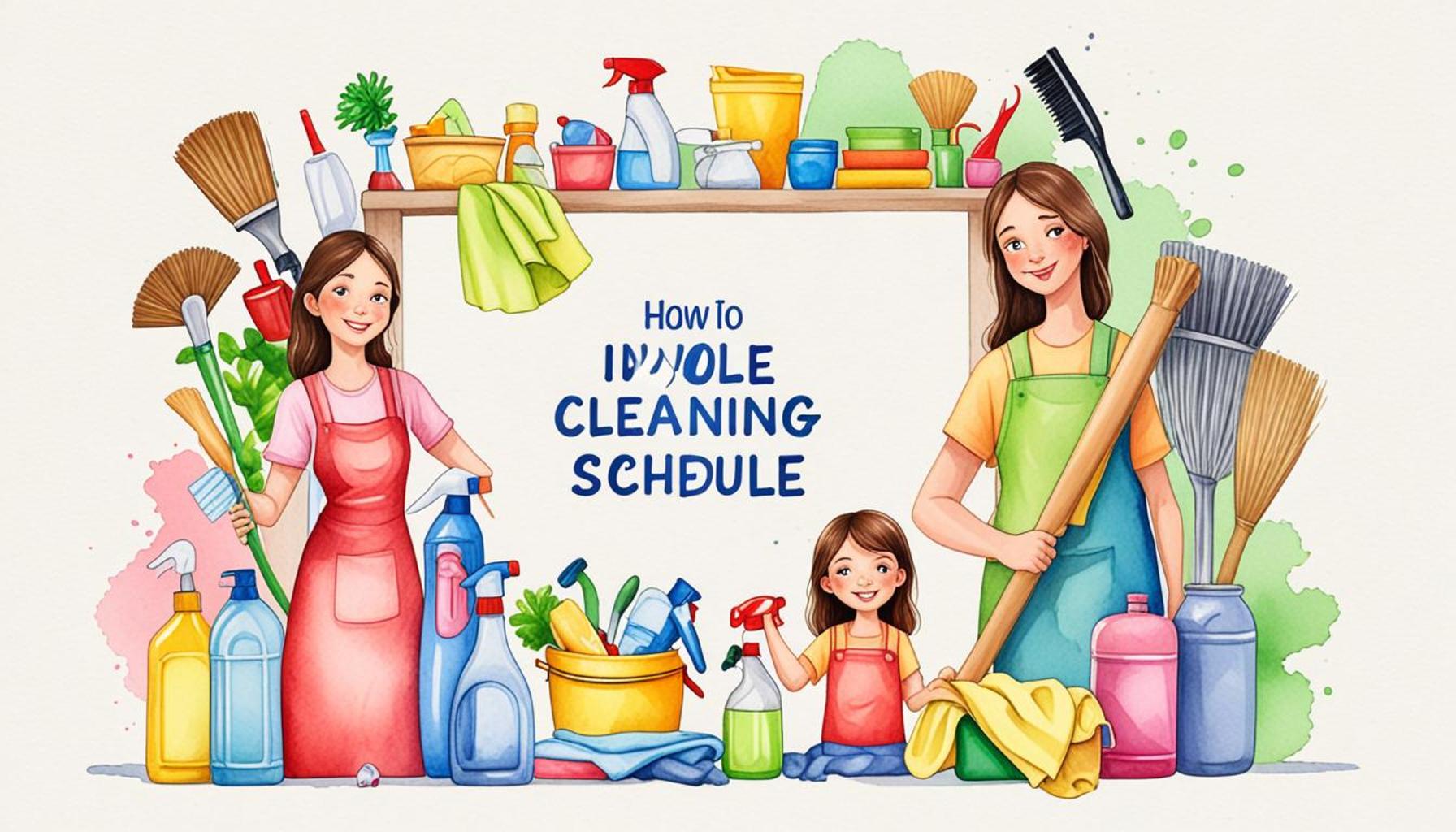How to Involve the Whole Family in Creating and Executing a Cleaning Schedule

Making Cleaning a Family Affair
Cleaning can often feel like a chore, but it doesn’t have to be. When the entire family gets involved in the process of creating and executing a cleaning schedule, it transforms into an engaging activity that builds responsibility and teamwork. The key to a successful family cleaning routine lies in collaborative planning and execution, making it not just a household duty, but an opportunity for bonding and shared accomplishment. Discover how to make cleaning a collaborative effort with these effective approaches.
Draft a Family Meeting
Start by gathering everyone for a family meeting. This creates an open forum where each family member can voice their opinions about cleaning and make suggestions. For instance, you might consider discussing which rooms tend to get messiest and how often they need attention. Utilize tools like a whiteboard or a notepad to jot down ideas and prioritize tasks. Everyone should have the chance to contribute, ensuring that all voices are respected and heard. By establishing a family cleaning routine together, you foster a sense of ownership among all members.
Delegate Tasks
Once you have a cleaning schedule in place, it’s time to delegate tasks based on age and preferences. Younger children can tackle fun and simple chores like dusting with colorful rags or picking up toys, while older children might handle vacuuming or bathroom cleaning. It’s important to match tasks with abilities; for example, a teenager might take on laundry or meal prep as part of an organization effort. This not only helps in removing the cleaning burden from one person but also teaches everyone valuable life skills and instills a sense of pride in contributing to the home.
Incorporate Rewards
Incentives are a powerful motivator when it comes to accomplishing household chores. Consider incorporating a reward system that celebrates achievements. Rewards can vary from a weekly family movie night, a special dessert, or even small monetary allowances for completed chores. For instance, a point system can be devised where members earn points for each completed task, which can later be exchanged for a fun outing or extra screen time on weekends. This encourages consistent participation and helps children associate cleaning with positive outcomes.
Sharing responsibilities not only lightens the load but also instills a sense of ownership in maintaining the household. Research indicates that families who work together on keeping their homes clean tend to foster stronger connections. Moreover, involving children from a young age teaches lifelong skills in organization and responsibility, which they will carry into adulthood.

In this article, we will explore step-by-step methods, tips, and resources that can help you involve the whole family in the cleaning process. Learn how to create an efficient schedule that suits all busy lifestyles and ensures that everyone contributes. Say goodbye to the cleaning burden and hello to teamwork!
DISCOVER MORE: Click here to learn about mindful cleaning techniques
Creating a Collaborative Cleaning Environment
To effectively engage the whole family in creating and executing a cleaning schedule, it’s essential to foster a collaborative environment. This involves emphasizing communication and understanding among all family members. When everyone feels responsible for maintaining a clean home, it encourages participation and accountability. Here are some methods to enhance family cooperation and commitment in managing household chores.
Set Clear Expectations
To begin with, it’s crucial to clarify expectations regarding cleanliness and responsibilities. During your family meeting, outline what a “clean” home looks like for your household. Discuss specific areas that require regular upkeep, such as the kitchen, bathrooms, and living spaces. Make a list of essential tasks that need to be completed and explain how frequently each task should be done. Common household chores may include:
- Dusting and vacuuming common areas
- Cleaning bathrooms and kitchen appliances
- Doing laundry and changing bed linens
- Organizing toys and personal items in shared spaces
- Taking out the trash and recycling
Having a clear outline ensures that everyone understands their individual roles and the collective responsibility of maintaining a clean environment.
Utilize a Visual Cleaning Schedule
A visual cleaning schedule can significantly aid in keeping the family organized and accountable. Create a chart that displays assigned chores and designated days for each member. This can be done on a large whiteboard in a common area or digitally using an app that everyone can access. Here are some options for tools you can use:
- Chore charts with stickers for younger kids
- Shared online calendars for older children
- Family-specific cleaning apps that send reminders and notifications
The visual element serves as a daily reminder for the tasks at hand, reducing the likelihood of someone forgetting their responsibilities. Moreover, when family members mark off completed chores, it creates a sense of accomplishment that adds to the motivation to participate.
Encourage Open Discussion and Feedback
Involving everyone in the cleaning process means allowing each family member to share their thoughts and experiences. Schedule regular check-ins to discuss what’s working well or if something isn’t. These discussions could be casual conversations while cooking dinner or a dedicated time every month. Encourage each family member to provide feedback on the cleaning schedule and suggest improvements, as this promotes engagement and adaptability within your cleaning strategy.
Sustainability is the secret ingredient to making a family cleaning schedule successful. Remember that flexibility is key; there will be days when unexpected events disrupt the cleaning routine. By implementing these practices and encouraging each family member to take ownership, you’ll create a happy balance between responsibility and teamwork, making family cleaning a pleasurable responsibility rather than a tedious task.
| Advantage | Description |
|---|---|
| Shared Responsibility | Engaging the whole family ensures that tasks are not just placed on one person, promoting teamwork and reducing overwhelm. |
| Sense of Accomplishment | Involving everyone in the cleaning process fosters a sense of achievement and pride in maintaining a clean home. |
| Life Skills Development | Teaching children how to clean instills valuable life skills that are important for their independence. |
| Customized Cleaning Schedule | Creating a tailored plan allows families to prioritize tasks that suit everyone’s routine, ensuring efficiency. |
| Quality Family Time | Working together encourages bonding time, turning cleaning into a fun and engaging family activity. |
Involving the entire family in the creation and execution of a cleaning schedule transforms what is often seen as a tedious chore into a collaborative and dynamic experience. This method not only distributes cleaning responsibilities evenly among family members, but also serves to educate younger members about maintaining a clean living environment, enhancing their independence and responsibility. When the cleaning tasks are collectively decided upon, families can create customized schedules that fit their unique routines, allowing for flexibility and prioritization of responsibilities. The emotional benefits are equally significant — families bond over the shared goal of cleanliness, instilling a sense of accomplishment, satisfaction, and pride in their home. By framing cleaning as a positive family activity rather than a burden, families not only achieve cleanliness but also foster a loving and cooperative household atmosphere.
DISCOVER MORE: Click here to learn how to delegate cleaning tasks effectively
Empowering Family Members Through Ownership and Incentives
Engaging all family members in the cleaning process not only fosters a sense of shared responsibility but also empowers them through ownership. When individuals feel they have a stake in their environment, they are likelier to maintain it. Here’s how to seize that opportunity and motivate your household.
Assign Age-Appropriate Tasks
When distributing chores, it’s important to consider the age and capabilities of each family member. Younger children can tackle simple tasks, such as picking up toys or sorting laundry, while older children and adults can handle more complex responsibilities like cleaning the bathrooms or preparing the dining area for meals. By assigning age-appropriate tasks, you encourage participation while ensuring that everyone contributes without feeling overwhelmed. In fact, research shows that children who engage in household chores develop a sense of responsibility and improved problem-solving skills.
Incorporate Fun and Competition
Household cleaning doesn’t have to be a bland activity. Injecting fun into the process can keep morale high and make chores less of a burden. Turn cleaning into a game by setting timers to challenge family members to complete their tasks in a specific timeframe. This friendly sense of competition can make activities exciting. You could even host weekly “cleaning challenges” where the winner earns a small prize or even a family outing. Not only does this approach break the monotony, but it also encourages teamwork and collaboration among family members.
Establish a Reward System
In addition to making cleaning enjoyable, consider establishing a reward system to incentivize participation. This could range from small rewards such as stickers or extra screen time to larger incentives like a family movie night or a weekend outing. Allow family members the opportunity to accumulate points for completing designated tasks. This not only motivates them to be diligent but also promotes a long-term commitment to maintaining the cleaning schedule. According to child psychologist Dr. Laura Markham, positive reinforcement, when used appropriately, can significantly encourage desired behaviors in children.
Celebrate Collective Achievements
Don’t forget to celebrate the small victories along the way. Acknowledging collective accomplishments, whether it’s successfully completing a week of chores or maintaining a clutter-free living room for a month, can help boost morale. Create a “Clean Home Certificate” or host a fun family gathering to honor everyone’s hard work. Recognizing efforts not only reinforces positive behavior but cultivates a sense of unity and accomplishment within the family unit.
By empowering family members through ownership, blending fun with responsibilities, and incorporating positive reinforcement strategies, you’ll cultivate a nurturing environment where everyone collaborates harmoniously. Weathering the ups and downs of household chores together can transform cleaning from a mundane task into a fulfilling family affair, paving the way for lasting relationships and cooperative living.
DON’T MISS: Click here for tips on organizing your cleaning supplies
Conclusion: Building a Harmonious Cleaning Culture
Involving the whole family in creating and executing a cleaning schedule is not merely about maintaining a tidy home; it’s about fostering unity, collaboration, and responsibility among family members. By assigning age-appropriate tasks, you ensure that every individual can contribute, which builds a sense of ownership and pride in their environment. Incorporating elements of fun, such as friendly competitions and cleaning challenges, turns what is often seen as a mundane task into an engaging activity that everyone can look forward to.
The implementation of a reward system further motivates family members to maintain their commitment to the cleaning schedule. This strategy promotes positive reinforcement and builds intrinsic motivation towards teamwork and household harmony. As you celebrate collective achievements, no matter how small, the family bonds strengthen, instilling a sense of community and accomplishment that resonates beyond cleaning tasks.
Ultimately, when families come together to create and execute a cleaning schedule, they are also designing a healthier, more organized living space that reflects their collective values. As you embark on this journey of engaging your entire family in household chores, remember that the process is as significant as the end result. By investing time in cooperation and communication, you’re not just cleaning your home; you’re cultivating lasting relationships and teaching life skills that will benefit your family for years to come. Embrace the challenge, and watch your home transform into a well-loved sanctuary.


